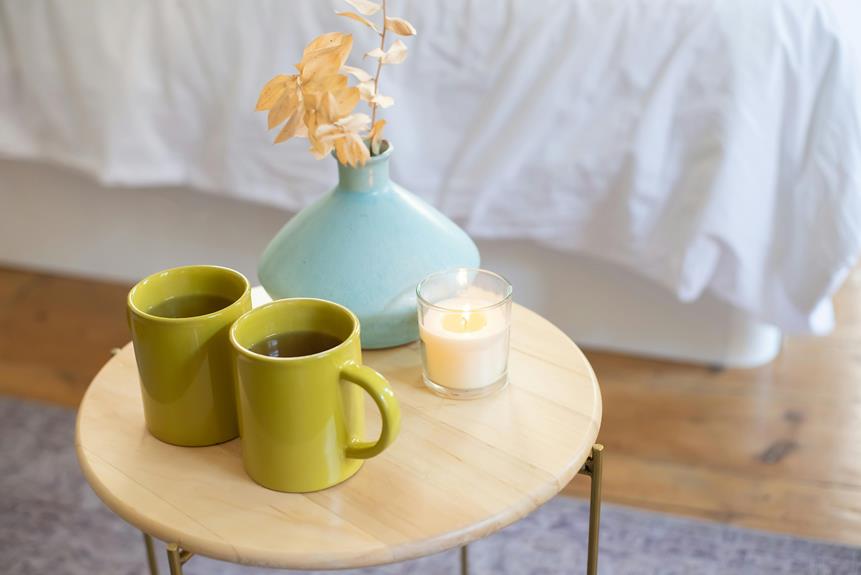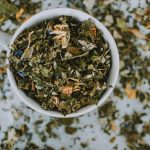If you're exploring the world of fabric dyeing, understanding which teas yield the best results can enhance your projects significantly. You might find that green tea produces soft pastels, while black tea offers rich, warm browns that add depth. Herbal options, like chamomile and hibiscus, bring vibrant colors to life, each with its own unique charm. As you consider these choices, think about how different teas can transform your fabric into something extraordinary. But what about the other options that could elevate your dyeing experience even further?
Table of Contents
Key Takeaways
- Green tea creates soft pastel shades, ideal for delicate dyeing projects; steep for at least 15 minutes for rich color infusion.
- Black tea produces rich brown tones, requiring a steep time of 5 to 7 minutes at 200°F for optimal extraction.
- Rooibos tea offers warm red hues, brewed at 200°F for 5 to 7 minutes to enhance its naturally sweet flavor.
- Herbal teas like chamomile, hibiscus, and turmeric yield vibrant yellows, reds, and warm tones, each with unique flavor profiles.
Green Tea for Soft Pastels
Green tea's gentle tannins make it an ideal choice for creating soft pastel shades in your dyeing projects. When you want to achieve a delicate hue, green tea offers a subtle approach that won't overpower your fabric. The key is to use high-quality loose leaf green tea, as it provides the richest color and best results.
Start by brewing a strong tea infusion; you'll want to steep the leaves for at least 15 minutes in boiling water. Once your tea is ready, let it cool slightly. While it cools, prepare your fabric by washing it to remove any finishes that could interfere with dye absorption.
Next, soak the fabric in the cooled green tea solution. The longer you leave the fabric, the deeper the pastel shade will become, so feel free to experiment. After you're satisfied with the color, rinse the fabric in cold water to set the dye.
Don't forget to hang it up to dry away from direct sunlight, as this can fade the soft colors. With green tea, you can create beautiful, gentle pastels that enhance your projects with a natural touch.
Black Tea for Rich Browns
When you choose black tea for rich browns, you'll want to focus on the brewing techniques that bring out its depth and flavor.
Understanding the profiles and notes of different black teas can enhance your experience, while also reaping the health benefits they offer.
Let's explore how to brew the perfect cup and appreciate the complexity of black tea.
Brewing Techniques for Depth
To achieve rich, deep browns with black tea, focus on the brewing time and water temperature for optimal extraction. Start by using water heated to around 200°F (93°C). This temperature ensures that the tea leaves release their full potential, creating a robust color.
Next, steep your tea for about 5 to 7 minutes. Experimenting with the time can help you find the perfect balance between richness and bitterness. Remember, the longer you brew, the deeper the hue.
Here's a quick reference table to guide you:
| Brewing Factor | Recommendation |
|---|---|
| Water Temperature | 200°F (93°C) |
| Steeping Time | 5 to 7 minutes |
| Tea-to-Water Ratio | 1 tablespoon per cup (8 oz) |
With these techniques, you'll discover the beauty of black tea's deep browns. Don't hesitate to adjust the variables based on your personal preference. The journey to the perfect brew is part of the experience, and the rich colors will surely evoke a sense of satisfaction in your crafting process.
Flavor Profiles and Notes
Black tea offers a complex flavor profile that enhances its rich browns, featuring notes of malt, caramel, and a subtle astringency that can elevate your brewing experience. These flavors create a delightful interplay that not only satisfies your palate but also adds depth to your tea.
When you brew black tea, you can expect a variety of nuanced flavors, including:
- Maltiness: A robust, earthy quality that grounds the overall taste.
- Caramel undertones: Sweet notes that bring warmth and richness.
- Astringency: A crisp finish that cleanses the palate.
- Fruity hints: Subtle flavors like berry or stone fruit can emerge, adding complexity.
These elements combine to create a full-bodied experience that's perfect for achieving deep, rich brown stains.
Whether you're using it for dyeing fabrics or enhancing culinary dishes, understanding these flavor profiles will help you make the most of black tea's unique characteristics.
Enjoy the journey of exploration as you brew and appreciate each cup!
Health Benefits of Black Tea
Discovering the health benefits of black tea not only enhances your well-being but also contributes to achieving those rich brown stains you desire. Packed with antioxidants, black tea helps combat free radicals, which can damage your cells and contribute to aging. By sipping on black tea regularly, you're not just treating your taste buds; you're also boosting your overall health.
Studies show that black tea can improve heart health by reducing blood pressure and cholesterol levels. It can also support digestive health, thanks to its natural compounds that promote gut flora balance.
Plus, the caffeine in black tea gives you a gentle energy boost without the jitters, making it a perfect pick-me-up. You'll also appreciate that black tea can enhance your mental alertness and focus. The combination of caffeine and L-theanine helps you stay sharp and calm throughout the day.
Herbal Teas for Vibrant Hues
Herbal teas can create vibrant hues in your fabric, adding a natural touch to your dyeing projects. If you're looking to achieve rich colors without synthetic dyes, herbal teas are your go-to choice. Each type of herbal tea brings its own unique shade, making it easy to customize your creations.
Here are some herbal teas you can use for vibrant colors:
- Chamomile: Produces soft, sunny yellows.
- Hibiscus: Yields stunning reds and pinks.
- Turmeric: Offers bright, golden yellows.
- Red clover: Results in delicate lavender tones.
To dye with herbal teas, brew a strong infusion and soak your fabric in the mixture. The longer you leave your fabric in the dye, the more intense the color will be. It's essential to pre-treat your fabric to ensure better color absorption.
Experiment with different tea combinations for unique shades, and enjoy the process of transforming your fabric into stunning works of art. With herbal teas, you're not just dyeing; you're creating something beautiful and eco-friendly!
Rooibos Tea for Warm Reds
Rooibos tea offers a unique flavor profile that's both rich and slightly sweet, making it a great choice for warm reds.
You'll find that mastering the brewing techniques can enhance its natural sweetness and color intensity.
Let's explore how to get the most out of your rooibos experience.
Flavor Profile Insights
Often enjoyed for its naturally sweet flavor, Rooibos tea pairs beautifully with warm red hues, making it a favorite choice for those seeking a comforting beverage. This herbal tea not only enhances the aesthetic of your drink but also offers a delightful tasting experience. You'll appreciate its unique flavor profile that brings out the best in warm reds.
Consider these flavor characteristics when enjoying Rooibos tea:
- Sweetness: Its natural sweetness can reduce the need for added sugars.
- Nutty undertones: You'll notice a subtle nuttiness that complements the warmth of the red shades.
- Earthy notes: The grounding quality of Rooibos adds depth to your sipping experience.
- Hints of vanilla: These soft notes can elevate the flavor, making it feel indulgent.
Whether you're sipping it solo or pairing it with a light snack, Rooibos tea enriches your palate and complements the warm reds beautifully.
Enjoy the comforting embrace that this tea provides, making each cup a delightful journey into flavor.
Brewing Techniques Explained
When you want to brew the perfect cup of Rooibos tea to enhance those warm reds, pay attention to the water temperature and steeping time for the best flavor extraction.
Start by bringing your water to a boil, ideally around 200°F (93°C). This temperature helps unlock the rich, sweet notes Rooibos is known for.
Next, measure out about one teaspoon of loose Rooibos tea or one tea bag per cup. Place the tea in your infuser or directly in the pot if you prefer a more robust flavor.
Pour the hot water over the tea and let it steep for about 5 to 7 minutes. This duration is essential, as steeping too short can result in a weak flavor, while steeping too long might introduce bitterness.
After steeping, remove the tea leaves or bag to prevent over-extraction. You can enjoy your Rooibos tea plain, or add a splash of milk or a touch of honey to enhance its natural sweetness.
This preparation method ensures that you achieve those warm reds in your cup, providing a delightful experience each time. Enjoy your perfectly brewed Rooibos!
Chamomile for Light Cream Tones
Chamomile enhances light cream tones with its subtle, soothing hues that beautifully complement your style. If you're looking to achieve that delicate, sun-kissed look, chamomile is your go-to option. This tea not only adds a gentle tint but also promotes a soft, natural glow in your hair and skin.
When using chamomile for light cream tones, consider the following benefits:
- Natural Highlights: It naturally lightens your hair, adding sunlit streaks without harsh chemicals.
- Soothing Properties: The calming effects of chamomile can reduce irritation on your skin.
- Antioxidant Boost: Packed with antioxidants, it helps protect your hair and skin from environmental damage.
- Versatile Use: You can brew chamomile tea for rinses or infuse it into oils for a nourishing treatment.
To enjoy the best results with chamomile, steep the tea well before applying it. Whether you're aiming for a subtle glow or a more pronounced light cream tone, chamomile delivers a gentle touch that enhances your natural beauty.
Matcha for Deep Greens
For those seeking to enhance deep green tones, matcha offers a vibrant and rich option that elevates your look with its intense color. This finely ground green tea not only delivers a bold hue but also packs a nutritional punch, making it a fantastic choice for both aesthetics and health.
When using matcha, consider the following factors to achieve the best results:
| Factor | Recommendation |
|---|---|
| Quality | Use ceremonial grade matcha for the best color and flavor. |
| Preparation Method | Whisk with hot water for a smooth consistency. |
| Proportions | Start with 1-2 teaspoons of matcha per cup. |
| Steeping Time | Allow it to steep for 3-5 minutes for optimal flavor. |
| Mixing Ingredients | Blend with milk or milk alternatives for a creamy texture. |
White Tea for Subtle Shades
White tea offers a delicate and nuanced color that beautifully complements subtle shades in any aesthetic. If you're looking to achieve soft, understated tones, this tea is your go-to. It's perfect for those who appreciate a more refined approach to staining fabrics or materials. When using white tea, you'll find that it imparts a soft, translucent hue that enhances rather than overwhelms.
Here are a few ways to utilize white tea for achieving subtle shades:
- Fabric Softening: The gentle staining effect can soften the appearance of heavier fabrics.
- Layering Colors: Use white tea as a base layer to build upon with other colors.
- Natural Aging: It mimics the look of vintage items without harsh chemicals.
- Skin Tones: Ideal for creating natural, warm shades in skin tone applications.
Frequently Asked Questions
Can I Mix Different Teas for Unique Stain Colors?
Yes, you can mix different teas to create unique stain colors! Experimenting with combinations allows you to achieve various shades, enhancing your project's aesthetic. Just remember to test small samples before committing to larger batches.
How Long Should I Steep Tea for Optimal Staining?
To achieve optimal staining, you should steep your tea for about 10 to 15 minutes. This allows the color to intensify, giving you a richer stain. Adjust steeping time based on your desired shade.
Are There Any Fabrics That Should Be Avoided When Using Tea?
You should avoid using tea on delicate fabrics like silk and lace, as the staining process can damage their texture. Additionally, synthetic materials might not absorb the color as well, leading to uneven results.
Can These Teas Be Used for Food-Safe Dyeing?
Yes, these teas can be used for food-safe dyeing. They're natural and non-toxic, making them suitable for fabrics that come in contact with food. Just ensure you rinse thoroughly after dyeing to avoid any residue.
What Is the Best Way to Set the Tea Stain?
To set the tea stain, heat your fabric gently in an iron or dryer. Alternatively, you can use a vinegar-water solution to fix the color. Always test on a small area first to ensure desired results.
- A Guide to Fabric Dye Prices and Services in Bangladesh - June 20, 2025
- Twill Fabric Manufacturers in Bangladesh: A Sourcing Directory - June 20, 2025
- How to Source High-Quality Cotton Fabric From Bangladesh - June 20, 2025







